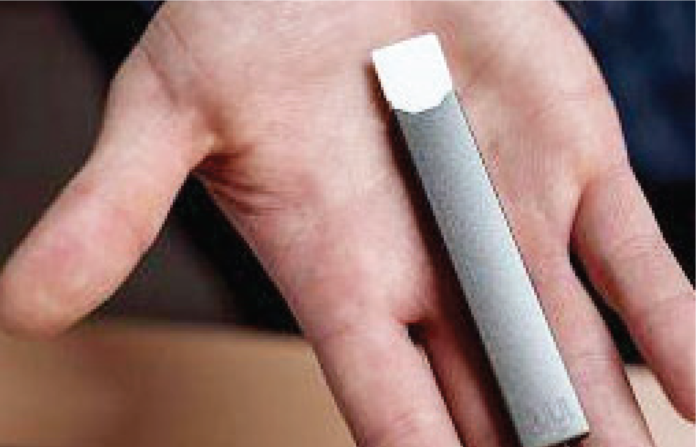by Christy Parrott
Across the country, teens are “lighting up” with JUUL e-cigarette devices. The JUULs are much easier to conceal than the traditional cigarettes previous generations snuck off to smoke in school bathrooms or behind the bleachers. JUULs give off little to no vapor or scent, and they can disappear inside a closed fist. The discreetness of the JUUL, in particular, allows brazen students to not only smoke or “vape” on school property but in classrooms, as well.
Local, Patti Humber steps up to call out the issue: “I think it’s sad and ridiculous, the money they’re spending. I wish parents, teachers, and the community knew what was going on.”
As an employee of Kum and Go, Humber has witnessed local high-school students, though of legal age to make the purchase, spend quite a bit of money on the JUUL products. And social media doesn’t help, with peers bragging about the various ways they have gotten away with vaping on school property.
Meanwhile as JUUL claims their product is an alternative for adult smokers, they’re also introducing a new generation to the potential of a lifelong habit. Through clever marketing, JUUL falsely implies their product is healthy, naming their “flavors” Ginger Peach Tea, Spicy Watermelon, Peanut and Jam, Crème Brule and the highly popular Mango, all of which bring to mind home and health through the subtle suggestion of fruit and comfort food. But are the JUUL e-cigarettes healthy? While e-cigarettes may contain fewer chemicals than cigarettes, they still expose people to cancercausing chemicals. Research hasn’t confirmed the exact health implications, but the liquid is a solution of propylene glycol, glycerin, and tobacco. One pod of a JUUL, for example, contains as much nicotine as a pack of cigarettes. Nicotine is highly addictive and affects parts of the developing teen brain, such as the prefrontal cortex, which is linked to decision making, emotions, and impulse control.
As far as the FDA is concerned, the jury is still out. Though, FDA Commissioner, Scott Gottleib named JUUL specifically when stating the agency will not “Tolerate the sale of any tobacco products to youth.” But, the FDA has around 4 years to make a firm decision of any kind; meanwhile, JUUL insists their products are meant as a path to smoking cessation. However, the CDC has stated there is “Currently no conclusive evidence that e-cigarettes promote long-term cessation, and e-cigarettes are not included as a recommended smoking cessation method by the US Public Health Service.”
Naturally, the e-cigarette companies are fighting back against regulation, insisting their products are an alternative to adult smokers, and some statistics show slightly improved lung health when switching over from traditional smokes. According to David Levy, professor of oncology at Georgetown University, “Results support the use of e-cigarettes… as an effective smoking cessation aid.”
But using e-cigarettes as an alternative to traditional smoking inherently points to the long-term damage of nicotine, itself. That damage and addiction starts when people smoke at a young age. UCLA medical professor Dr. Kien Vuu, reiterates this, stating, “It usually takes a lag time from an exposure of a carcinogen before cancer ensues,” essentially stating that there is no safe cigarette.
Furthermore, even if students are of age to purchase the JUUL, it’s against school policy. West Grand High School Principal Bower states, “Our school is a tobacco, drug and alcohol free zone. E-cigarettes are not permitted on school property, even if the students are of age.” If students are caught, they will be disciplined according to school policy, but aside from disciplinary issues, Principal Bower worries: “Kids aren’t realizing how bad it is for you. They think it’s cool, sleek and sexy. It’s a society problem, and I’d love to partner with anyone willing to help.”
So often, young adults smoke to defy authority; however, the impulse may be misguided by allowing Big Tobacco to have a lifelong hold on young consumers through nicotine addiction.









